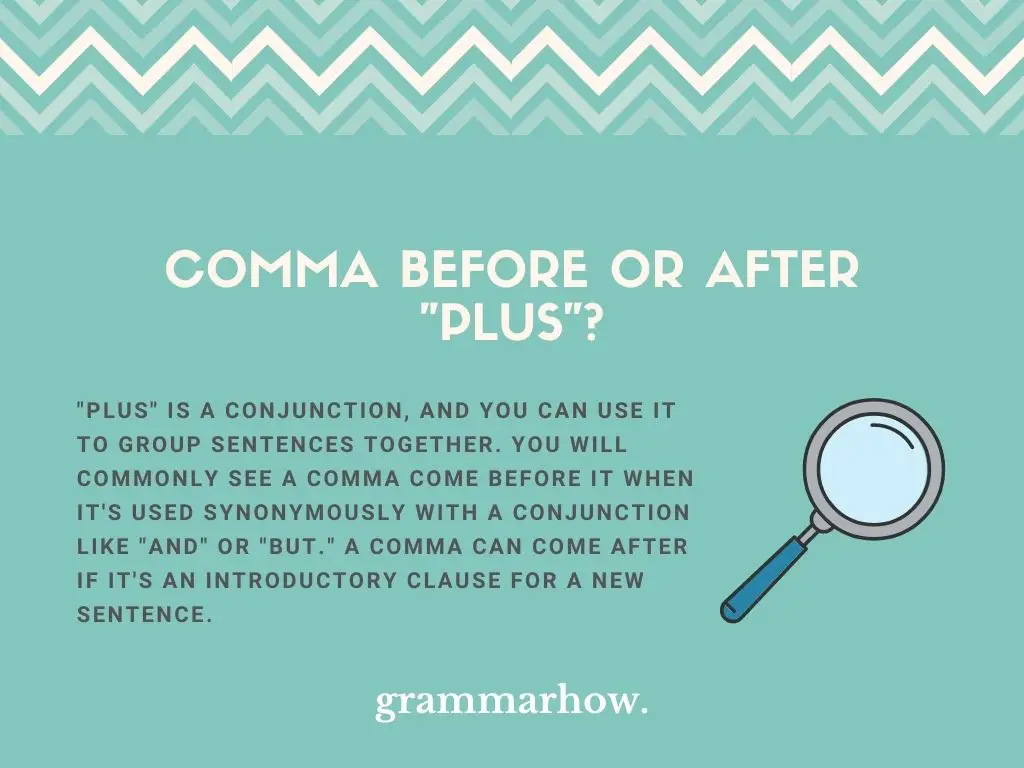Commas are very important when they’re used with certain words. Without them, sentences can feel a bit all over the place. Take “plus,” for example. You need to know how to place commas around it, and this article will explain all there is to know about it.
Comma Before or After “Plus”?
“Plus” is a conjunction, and you can use it to group sentences together. You will commonly see a comma come before it when it’s used synonymously with a conjunction like “and” or “but.” A comma can come after if it’s an introductory clause for a new sentence.

You will mainly find that “plus” works in the same way as “and.” You always want to include a comma before a coordinating conjunction like this to show where the break between the two sentences comes in.
- I did not want to go, plus I was told I didn’t have to.
If you were to remove “plus” from the sentence, you would be left with two complete sentences. That’s how conjunctions are supposed to work:
- I did not want to go. I was told I didn’t have to.
Comma Before “Plus”
A comma should come before “plus” when it is used to connect two sentences with each other. It is a coordinating conjunction when used in this way. You will find that removing “plus” allows you to split the sentences back into their original clauses.
- They wanted to see more of it, plus they weren’t sure what time they were supposed to go home.
- I’m uncertain about this, plus I thought there would be a few other people around here to help us make our decision.
- They couldn’t tell me the truth, plus they thought it would be easier if nobody knew what was happening behind closed doors.
- I thought about it, plus I knew I needed to spend some time getting to know them all better. I guess I was wrong.
- I couldn’t have done it alone, plus I’m fairly sure that nobody else was willing to help me out. I thought I could trust them.
Comma After “Plus”
You can place a comma after “plus” when it is used to link two independent clauses. When this happens, a semicolon will also have to be present before “plus.” You can also start a new sentence with “plus,” which requires a comma after it to become an introductory clause.
- I didn’t want to make it work like this. Plus, I knew there was going to have to be another way for us to get through it.
- I told you not to go there; plus, I said that it would have been much easier if we all went together when we knew it was safe.
- We didn’t think much about it; plus, we thought that we knew better than most people anyway. We were clearly wrong.
- I thought you would say something like that; plus, you always seem to act like you know what’s supposed to happen next.
- I’m not going to discuss this further with you; plus, I don’t believe it’s fair for you to act in an unreasonable way.
Can You Start a Sentence With “Plus”?
You can start a sentence with “plus” when you want to use it as an introductory clause. If the sentence beforehand had been too long with “plus” as a part of it, it makes more grammatical sense to include “plus” as a new word.
“Plus” at the beginning of a sentence is a great way for you to break up the flow of your writing.
For example:
- I didn’t think much of it, even though I knew I needed to make something happen. Plus, I was a bit lazy about these things.
Here, a new sentence is needed with “plus” because it would have been too long without it. If you replaced the period before “plus” with a comma, you would find that the resulting sentence is a jumbled mess that does not allow the reader to pause correctly.
Final Thoughts
“Plus” can have a comma before it if it’s used to connect two clauses. You can replace it with “and” in most of these cases to know whether you’ve used the comma right. It can have a comma after it when it’s an introductory clause or connecting two independent clauses.

Martin holds a Master’s degree in Finance and International Business. He has six years of experience in professional communication with clients, executives, and colleagues. Furthermore, he has teaching experience from Aarhus University. Martin has been featured as an expert in communication and teaching on Forbes and Shopify. Read more about Martin here.
